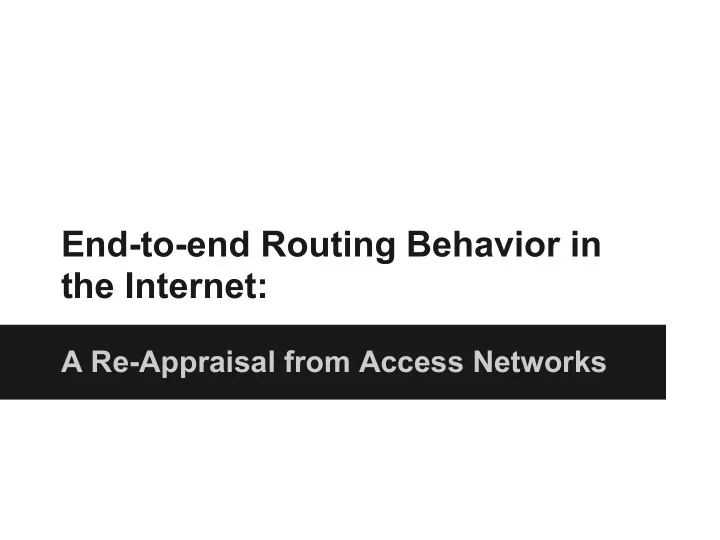

End-to-end Routing Behavior in the Internet: A Re-Appraisal from Access Networks
Introduction ● Large scale behavior of end-to-end routing ○ Collect traceroutes and other network performance metrics ○ BISmark routers all over the world ○ A unique view from home networks - users' POV ● Impact of current ISP policies on end-users
About the data ● MLAB servers and devices ● Approximately every 70 mins for each device ● 'UP' followed by 'DW' in 10 mins ● More than one year of traceroute data available ● 230+ devices, 59 servers
Questions we strive to answer: ● One or many ● Preferred path ● Periods of activity ● 'Intra-ISP' or 'inter-ISP' ● Effect on end user ○ Hops to destination, RTT ○ Associated changes in packet loss, bitrate, jitter ... ○ New path on 'busy' and/or 'expensive' route
Evaluation criteria Paxson's areas of interest: ● Prevalence ● Persistence ● Symmetry ● Pathologies
Routing weirdness ● Dealing with traceroutes: ○ Private addresses ○ Repetitions ○ Loops ○ Missing hops ● Errors? Loops? Pathologies? - Unknown ● Counting distinct paths
Example '216.195.172.175' '207.5.144.5' '207.5.146.130' '173.241.131.37' '143.215.131.1' '173.241.131.182' '130.207.254.45' '130.207.254.185' '141.136.109.138' '130.207.251.1' '89.149.182.170' '77.67.79.221' '65.114.55.137' '67.14.8.190' '66.55.208.62'
Example Sanford Brunswick NYC NYC ? Boston Atlanta Chicago Denver ?
A quick comparison Prevalence ● At IP granularity, half of the source- destination pairs had 2 or more prevalent paths ● At AS granularity, single path dominates (overall mean was 0.92**) Persistence ● Fast variations (every next measurement) ● Constant for almost a week
Future Work ● Relationship between path fluctuations and other performance metrics ● Time-of-the-day patterns, evidence of traffic engineering ● Pathologies ● Changes near last mile v/s core Internet
Why am I here then? ● Share the data - MLAB (coming) ● Get suggestions from the Internet measurement community ● Ideas on what to do next - other tools - as a lot more BISmark users are getting added ● FCC v/s ISPs - what would you like to look at from access networks POV
Thanks!
Extra
Current work ● A work in progress ● Glimpse at ~ 44,000 measurements over 10 days ● source-destination pairs in only UP direction: 171 ● source-destination pairs in only DW direction: 131 ● source-destination pairs with bidirectional data: 123
Number of distinct paths Of 249 source-destination pairs, only 119 with a single prevalent path at prefix 16.
AS level
AS level
Example 1
Example 1
Example 2
Example 3
Example 3
Recommend
More recommend